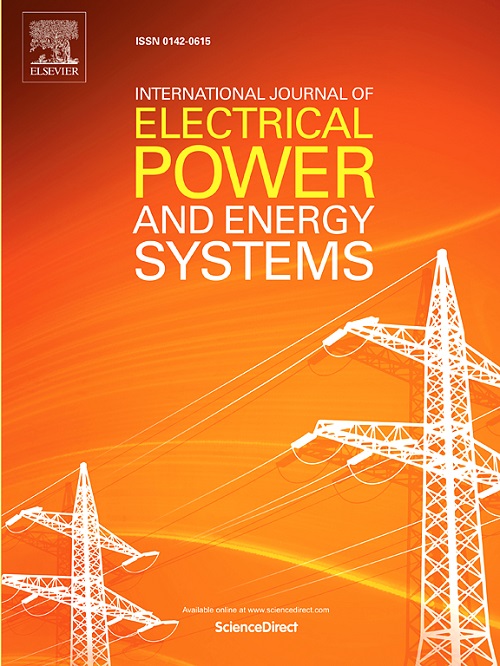Experimental evaluation of an advanced predictive control technique for variable-speed wind turbine systems
IF 5
2区 工程技术
Q1 ENGINEERING, ELECTRICAL & ELECTRONIC
International Journal of Electrical Power & Energy Systems
Pub Date : 2025-04-16
DOI:10.1016/j.ijepes.2025.110668
引用次数: 0
Abstract
Wind energy control plays a crucial role in optimizing the performance of Doubly Fed Induction Generators (DFIGs) by maximizing power extraction while ensuring stable grid integration. To achieve this, a Maximum Power Point Tracking (MPPT) strategy is employed to determine the optimal mechanical speed and reference power, enabling efficient wind energy conversion. However, maintaining precise control over the active and reactive power exchange remains a challenge, especially under varying operating conditions. This paper presents an experimental study on the application of deadbeat predictive control to a DFIG-based wind energy system, integrating MPPT for optimal power tracking. The study, conducted using a DSPACE DS1104 test bench, includes the development of a comprehensive mathematical model, an analysis of the deadbeat control strategy, and its implementation in MATLAB/Simulink. Experimental validation demonstrates that the proposed control method achieves faster response time (0.0504 s), reduced Total Harmonic Distortion (THD) to 0.5 %, and enhanced robustness against parameter variations, ensuring both maximum power extraction and high-quality power injection into the grid. These results confirm the superiority of the MPPT-integrated deadbeat predictive control over conventional methods in terms of efficiency, power quality, and system stability. However, while this method shows promising results, its implementation in real-world, large-scale systems requires further investigation to address challenges such as grid stability under fluctuating conditions and the scalability of the control strategy. In terms of practical implications, the proposed control method offers potential for improving the performance and efficiency of DFIG-based wind energy systems, contributing to more sustainable and reliable energy production. The research also holds social implications by advancing renewable energy technologies, which are essential for reducing dependency on fossil fuels and mitigating the effects of climate change.
一种先进的变转速风力发电系统预测控制技术的实验评价
风能控制对优化双馈感应发电机(DFIGs)的性能起着至关重要的作用,可以在保证稳定并网的同时最大限度地提取电能。为了实现这一目标,采用最大功率点跟踪(MPPT)策略来确定最佳机械速度和参考功率,从而实现高效的风能转换。然而,保持对有功和无功功率交换的精确控制仍然是一个挑战,特别是在不同的运行条件下。本文对无差拍预测控制在基于dfg的风电系统中的应用进行了实验研究,并结合MPPT进行了最优功率跟踪。该研究在DSPACE DS1104试验台上进行,包括建立综合数学模型,分析无差拍控制策略,并在MATLAB/Simulink中实现。实验验证表明,该控制方法实现了更快的响应时间(0.0504 s),将总谐波失真(THD)降低到0.5%,并增强了对参数变化的鲁棒性,确保了最大功率提取和高质量的电网注入。这些结果证实了mpt集成无差拍预测控制在效率、电能质量和系统稳定性方面优于传统方法。然而,虽然这种方法显示出有希望的结果,但它在现实世界中的大规模系统的实现需要进一步的研究,以解决诸如波动条件下电网稳定性和控制策略的可扩展性等挑战。就实际意义而言,所提出的控制方法为提高基于dfig的风能系统的性能和效率提供了潜力,有助于实现更可持续和可靠的能源生产。这项研究还通过推进可再生能源技术而具有社会意义,这对于减少对化石燃料的依赖和减轻气候变化的影响至关重要。
本文章由计算机程序翻译,如有差异,请以英文原文为准。
求助全文
约1分钟内获得全文
求助全文
来源期刊
CiteScore
12.10
自引率
17.30%
发文量
1022
审稿时长
51 days
期刊介绍:
The journal covers theoretical developments in electrical power and energy systems and their applications. The coverage embraces: generation and network planning; reliability; long and short term operation; expert systems; neural networks; object oriented systems; system control centres; database and information systems; stock and parameter estimation; system security and adequacy; network theory, modelling and computation; small and large system dynamics; dynamic model identification; on-line control including load and switching control; protection; distribution systems; energy economics; impact of non-conventional systems; and man-machine interfaces.
As well as original research papers, the journal publishes short contributions, book reviews and conference reports. All papers are peer-reviewed by at least two referees.

 求助内容:
求助内容: 应助结果提醒方式:
应助结果提醒方式:


